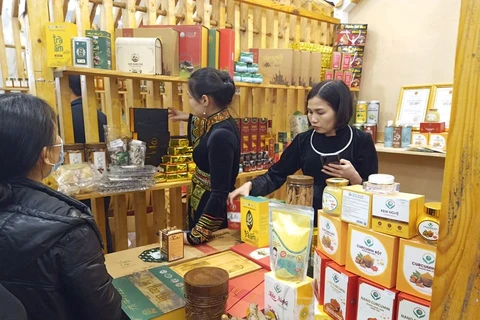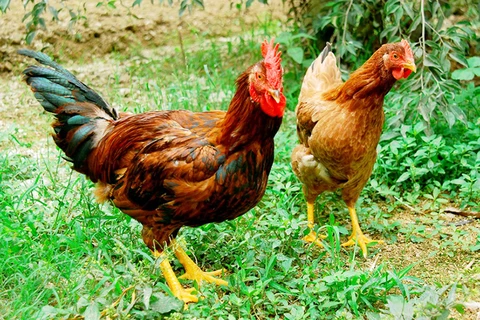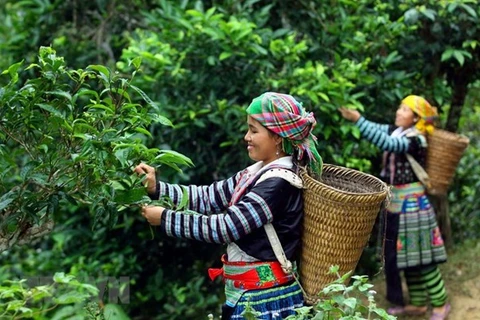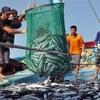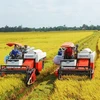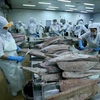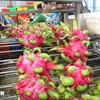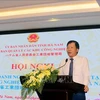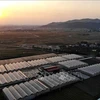Hanoi (VNA) – The northern province of Quang Ninh is working to turn the “One Commune, One Product” (OCOP) into an important economic development programme carried out in tandem with new-style countryside building and agricultural restructuring during the 2021 - 2025 period.
During the period, it is set to develop 300 new OCOP products, at least 250 of which will be rated three to five stars, with the participation of at least 50 economic organisations.
Between 2017 and 2020, the local OCOP programme had its focus switched from quantity to quality as more than 200 products were rated three to five stars, which is said to have helped improve rural residents’ living conditions and contributed to the building of new-style rural areas, the Nong nghiep Vietnam (Agriculture of Vietnam) newspaper reported.
Quang Ninh, one of the three nuclei of the northern key economic region, has implemented the OCOP programme since 2013, and it is now taking the lead nationwide in this regard.
The local programme entered a new phase in 2017 with the aim of developing large-scale concentrated production, which focuses on diversifying and intensively processing products under value chains in order to increase benefits for the local community.
The collective and private economic sectors were identified as important driving forces for this programme.
At present, Quang Ninh has 456 items in the OCOP programme, 236 of which have been granted ratings of three to five stars. To be given star ratings, those products have met basic, even advanced, standards, been made in modern and professional manufacturing processes, and had their packages and labels perfected.
OCOP products have generated an average of 500 billion - 700 billion VND (22 -million - 31 million USD) in annual revenue for the province.
Achievements in the OCOP programme have substantially contributed to the building of new-style countryside, which is a national target programme, in Quang Ninh.
As a result, per capita income in local rural areas rose to 47 million VND in 2020 from 10.5 million VND in 2010.
Quang Ninh has set a goal to have modern industry and service sectors and become one of the region’s comprehensive and dynamic development hubs by 2025. The province looks to raise its gross regional domestic product (GRDP) by 10 percent on an annual average during 2020 - 2025, and the per capita GRDP to over 10,000 USD by 2025. The urbanisation rate is expected to surpass 75 percent, while the rate of poor households to go down to below 1 percent.
The province plans to complete the new-style rural area building by the end of 2030.
The OCOP was initiated by the Ministry of Agriculture and Rural Development in 2008, based on Japan’s “One Village, One Product” and Thailand’s “One Tambon, One Product” programmes. It is an economic development programme for rural areas and focuses on increasing internal power and values, and is also to help with the national target programme on new-style rural area building.
Vietnam verified, rated, and recognised a total of 3,200 products as OCOP goods last year, 800 higher than planned, according to the Ministry of Agriculture and Rural Development.
OCOP products are produced basing on the combination of local resources, traditional culture, and advanced technology, thus promoting product diversification, quality, packaging, and origin traceability.
The programme has provided farmers with the chance to come together to form cooperatives, which now account for 38 percent of 1,400 OCOP producers nationwide. The establishment of these cooperatives has in turn enabled farmers to create goods with better quality, design, and packaging that meet higher standards and match market demand./.
During the period, it is set to develop 300 new OCOP products, at least 250 of which will be rated three to five stars, with the participation of at least 50 economic organisations.
Between 2017 and 2020, the local OCOP programme had its focus switched from quantity to quality as more than 200 products were rated three to five stars, which is said to have helped improve rural residents’ living conditions and contributed to the building of new-style rural areas, the Nong nghiep Vietnam (Agriculture of Vietnam) newspaper reported.
Quang Ninh, one of the three nuclei of the northern key economic region, has implemented the OCOP programme since 2013, and it is now taking the lead nationwide in this regard.
The local programme entered a new phase in 2017 with the aim of developing large-scale concentrated production, which focuses on diversifying and intensively processing products under value chains in order to increase benefits for the local community.
The collective and private economic sectors were identified as important driving forces for this programme.
At present, Quang Ninh has 456 items in the OCOP programme, 236 of which have been granted ratings of three to five stars. To be given star ratings, those products have met basic, even advanced, standards, been made in modern and professional manufacturing processes, and had their packages and labels perfected.
OCOP products have generated an average of 500 billion - 700 billion VND (22 -million - 31 million USD) in annual revenue for the province.
Achievements in the OCOP programme have substantially contributed to the building of new-style countryside, which is a national target programme, in Quang Ninh.
As a result, per capita income in local rural areas rose to 47 million VND in 2020 from 10.5 million VND in 2010.
Quang Ninh has set a goal to have modern industry and service sectors and become one of the region’s comprehensive and dynamic development hubs by 2025. The province looks to raise its gross regional domestic product (GRDP) by 10 percent on an annual average during 2020 - 2025, and the per capita GRDP to over 10,000 USD by 2025. The urbanisation rate is expected to surpass 75 percent, while the rate of poor households to go down to below 1 percent.
The province plans to complete the new-style rural area building by the end of 2030.
The OCOP was initiated by the Ministry of Agriculture and Rural Development in 2008, based on Japan’s “One Village, One Product” and Thailand’s “One Tambon, One Product” programmes. It is an economic development programme for rural areas and focuses on increasing internal power and values, and is also to help with the national target programme on new-style rural area building.
Vietnam verified, rated, and recognised a total of 3,200 products as OCOP goods last year, 800 higher than planned, according to the Ministry of Agriculture and Rural Development.
OCOP products are produced basing on the combination of local resources, traditional culture, and advanced technology, thus promoting product diversification, quality, packaging, and origin traceability.
The programme has provided farmers with the chance to come together to form cooperatives, which now account for 38 percent of 1,400 OCOP producers nationwide. The establishment of these cooperatives has in turn enabled farmers to create goods with better quality, design, and packaging that meet higher standards and match market demand./.
VNA

